2016 NISSAN LEAF mirror
[x] Cancel search: mirrorPage 257 of 437
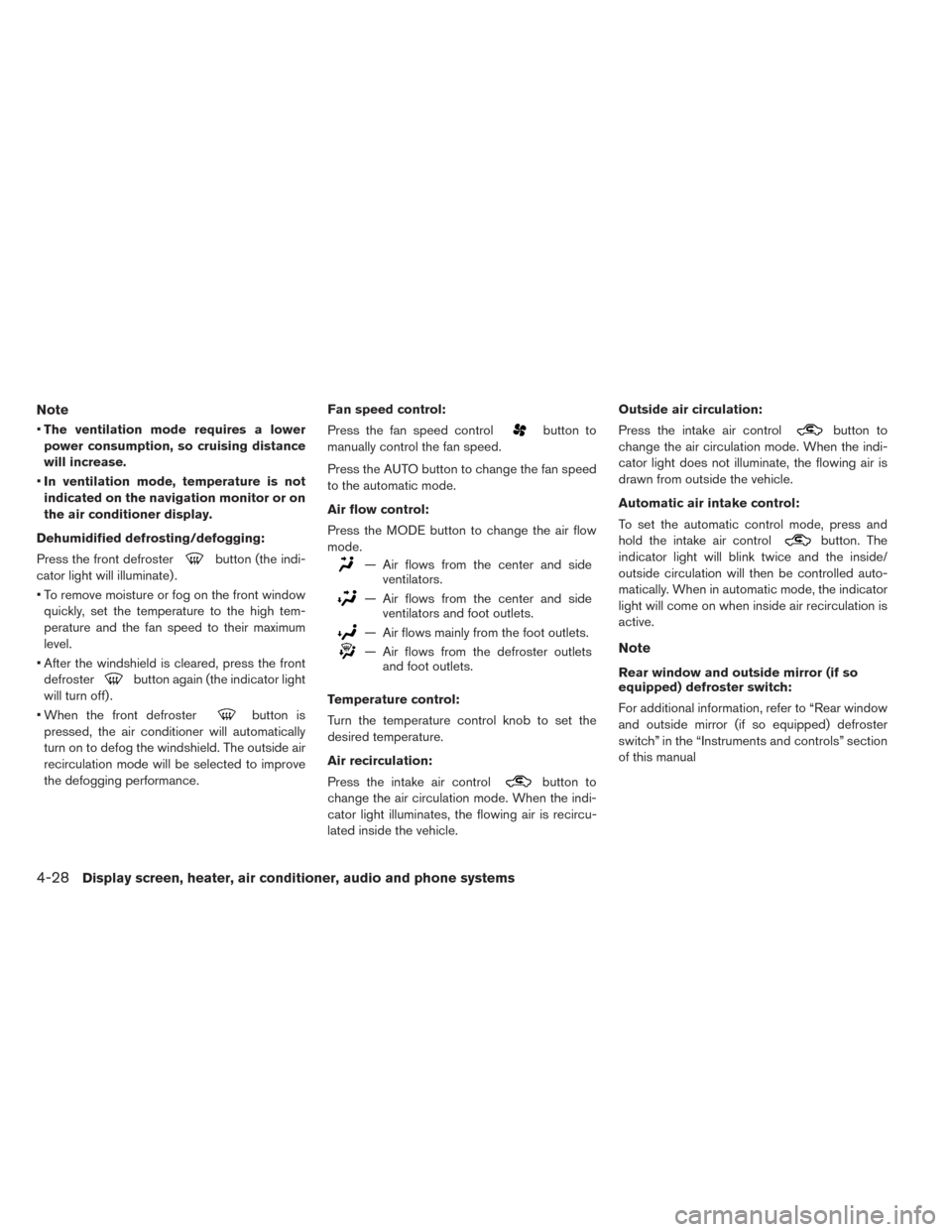
Note
•The ventilation mode requires a lower
power consumption, so cruising distance
will increase.
• In ventilation mode, temperature is not
indicated on the navigation monitor or on
the air conditioner display.
Dehumidified defrosting/defogging:
Press the front defroster
button (the indi-
cator light will illuminate) .
• To remove moisture or fog on the front window quickly, set the temperature to the high tem-
perature and the fan speed to their maximum
level.
• After the windshield is cleared, press the front defroster
button again (the indicator light
will turn off) .
• When the front defroster
button is
pressed, the air conditioner will automatically
turn on to defog the windshield. The outside air
recirculation mode will be selected to improve
the defogging performance. Fan speed control:
Press the fan speed control
button to
manually control the fan speed.
Press the AUTO button to change the fan speed
to the automatic mode.
Air flow control:
Press the MODE button to change the air flow
mode.
— Air flows from the center and side ventilators.
— Air flows from the center and sideventilators and foot outlets.
— Air flows mainly from the foot outlets.
— Air flows from the defroster outletsand foot outlets.
Temperature control:
Turn the temperature control knob to set the
desired temperature.
Air recirculation:
Press the intake air control
button to
change the air circulation mode. When the indi-
cator light illuminates, the flowing air is recircu-
lated inside the vehicle. Outside air circulation:
Press the intake air control
button to
change the air circulation mode. When the indi-
cator light does not illuminate, the flowing air is
drawn from outside the vehicle.
Automatic air intake control:
To set the automatic control mode, press and
hold the intake air control
button. The
indicator light will blink twice and the inside/
outside circulation will then be controlled auto-
matically. When in automatic mode, the indicator
light will come on when inside air recirculation is
active.
Note
Rear window and outside mirror (if so
equipped) defroster switch:
For additional information, refer to “Rear window
and outside mirror (if so equipped) defroster
switch” in the “Instruments and controls” section
of this manual
4-28Display screen, heater, air conditioner, audio and phone systems
Page 262 of 437
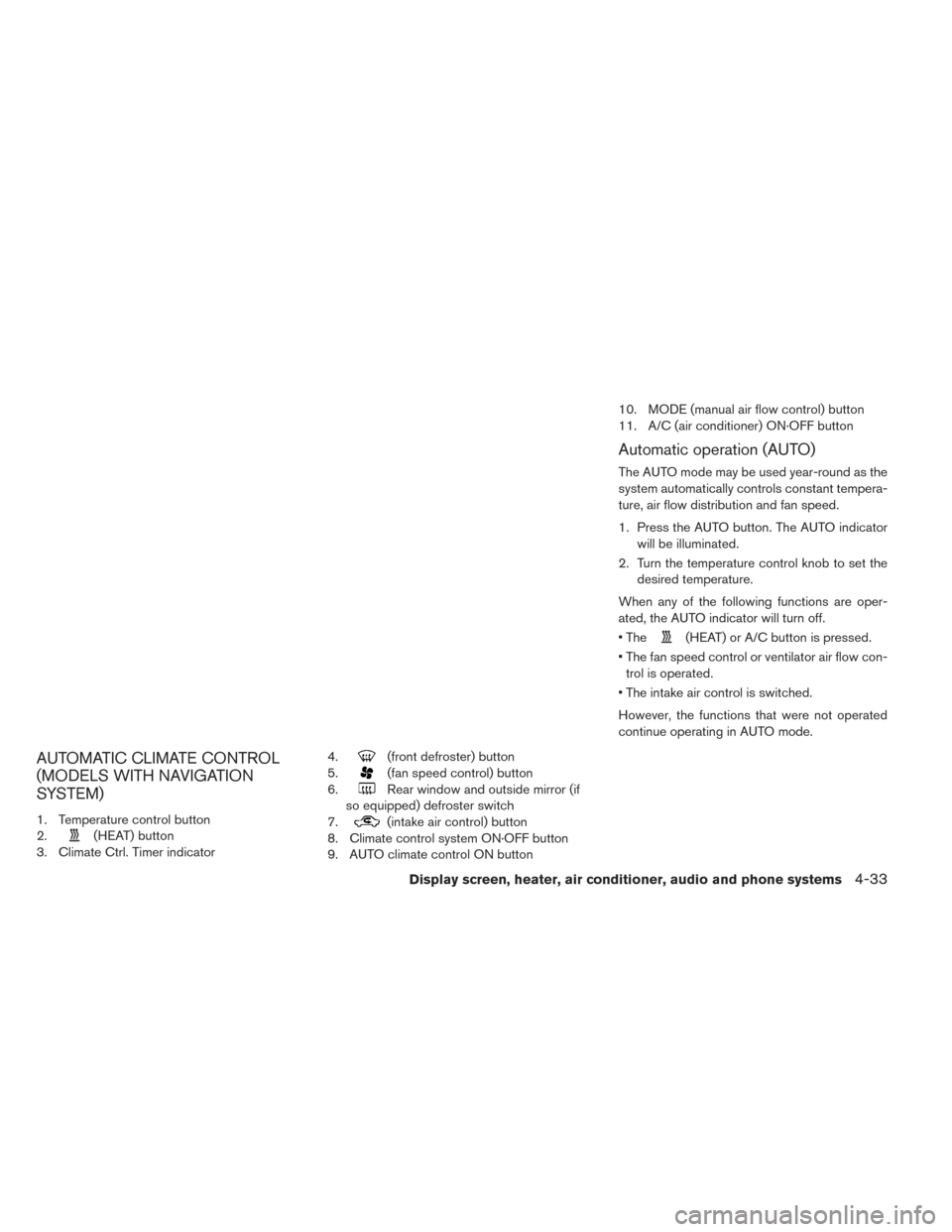
AUTOMATIC CLIMATE CONTROL
(MODELS WITH NAVIGATION
SYSTEM)
1. Temperature control button
2.
(HEAT) button
3. Climate Ctrl. Timer indicator 4.
(front defroster) button
5.
(fan speed control) button
6.
Rear window and outside mirror (if
so equipped) defroster switch
7.
(intake air control) button
8. Climate control system ON·OFF button
9. AUTO climate control ON button 10. MODE (manual air flow control) button
11. A/C (air conditioner) ON·OFF button
Automatic operation (AUTO)
The AUTO mode may be used year-round as the
system automatically controls constant tempera-
ture, air flow distribution and fan speed.
1. Press the AUTO button. The AUTO indicator
will be illuminated.
2. Turn the temperature control knob to set the desired temperature.
When any of the following functions are oper-
ated, the AUTO indicator will turn off.
• The
(HEAT) or A/C button is pressed.
• The fan speed control or ventilator air flow con- trol is operated.
• The intake air control is switched.
However, the functions that were not operated
continue operating in AUTO mode.
Display screen, heater, air conditioner, audio and phone systems4-33
Page 264 of 437
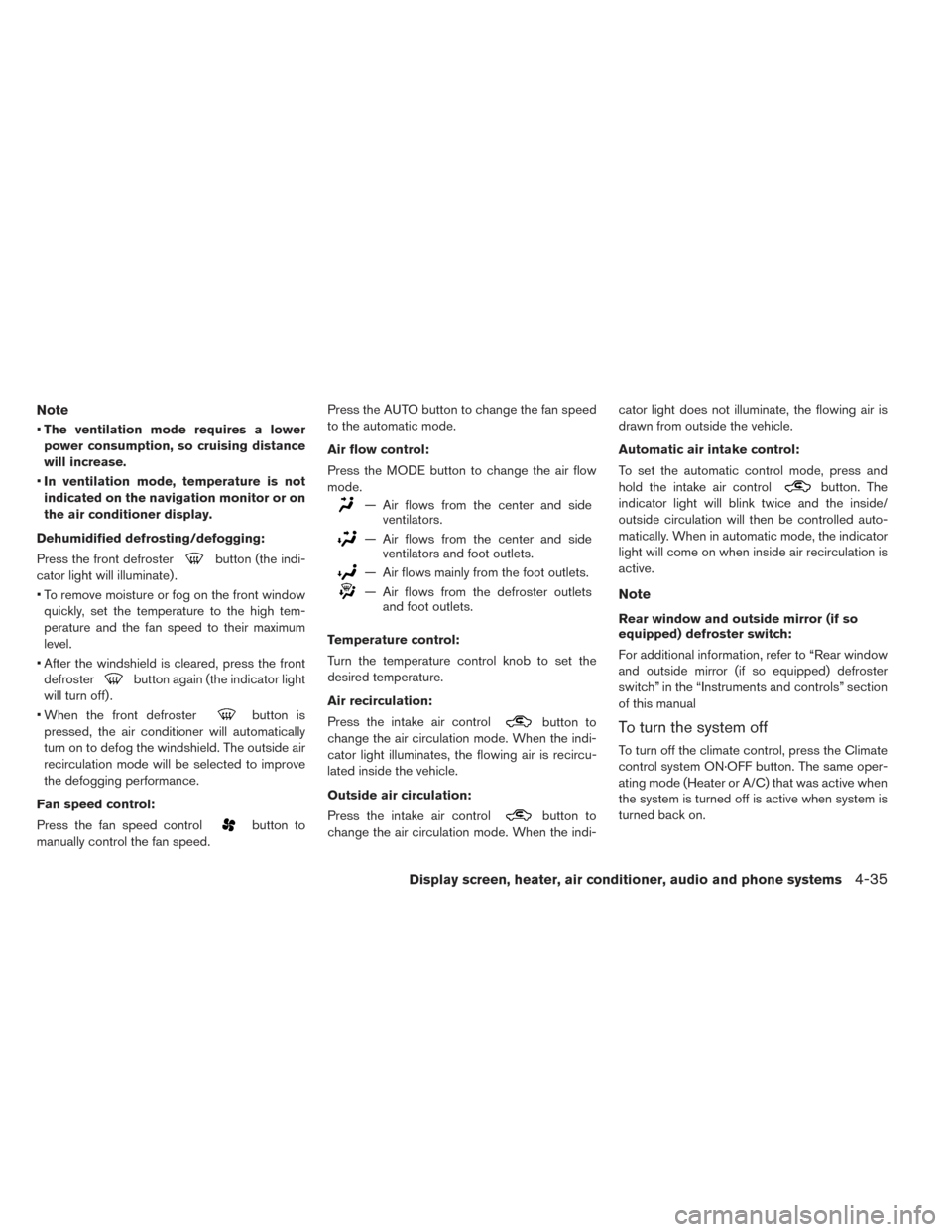
Note
•The ventilation mode requires a lower
power consumption, so cruising distance
will increase.
• In ventilation mode, temperature is not
indicated on the navigation monitor or on
the air conditioner display.
Dehumidified defrosting/defogging:
Press the front defroster
button (the indi-
cator light will illuminate) .
• To remove moisture or fog on the front window quickly, set the temperature to the high tem-
perature and the fan speed to their maximum
level.
• After the windshield is cleared, press the front defroster
button again (the indicator light
will turn off) .
• When the front defroster
button is
pressed, the air conditioner will automatically
turn on to defog the windshield. The outside air
recirculation mode will be selected to improve
the defogging performance.
Fan speed control:
Press the fan speed control
button to
manually control the fan speed. Press the AUTO button to change the fan speed
to the automatic mode.
Air flow control:
Press the MODE button to change the air flow
mode.
— Air flows from the center and side
ventilators.
— Air flows from the center and sideventilators and foot outlets.
— Air flows mainly from the foot outlets.
— Air flows from the defroster outletsand foot outlets.
Temperature control:
Turn the temperature control knob to set the
desired temperature.
Air recirculation:
Press the intake air control
button to
change the air circulation mode. When the indi-
cator light illuminates, the flowing air is recircu-
lated inside the vehicle.
Outside air circulation:
Press the intake air control
button to
change the air circulation mode. When the indi- cator light does not illuminate, the flowing air is
drawn from outside the vehicle.
Automatic air intake control:
To set the automatic control mode, press and
hold the intake air control
button. The
indicator light will blink twice and the inside/
outside circulation will then be controlled auto-
matically. When in automatic mode, the indicator
light will come on when inside air recirculation is
active.
Note
Rear window and outside mirror (if so
equipped) defroster switch:
For additional information, refer to “Rear window
and outside mirror (if so equipped) defroster
switch” in the “Instruments and controls” section
of this manual
To turn the system off
To turn off the climate control, press the Climate
control system ON·OFF button. The same oper-
ating mode (Heater or A/C) that was active when
the system is turned off is active when system is
turned back on.
Display screen, heater, air conditioner, audio and phone systems4-35
Page 312 of 437
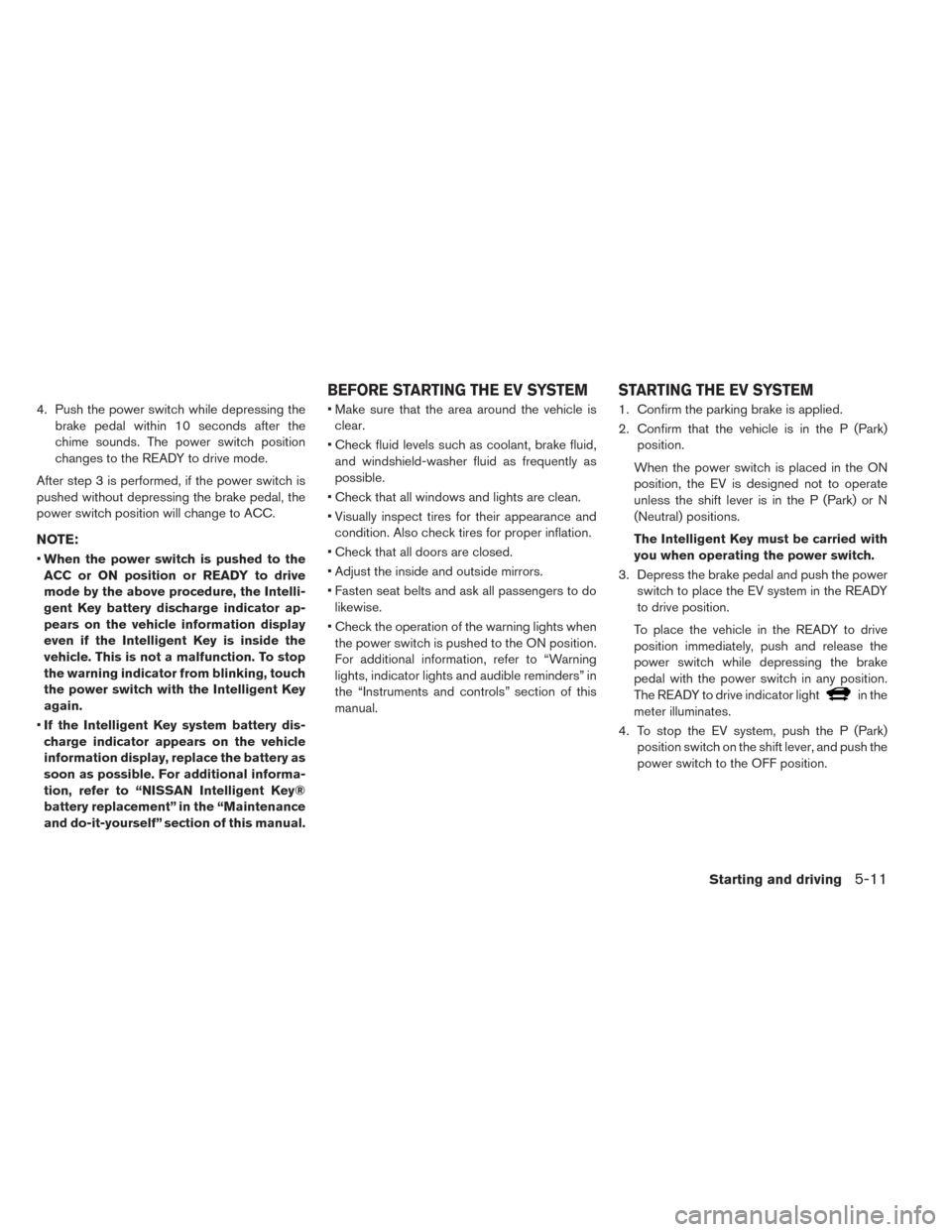
4. Push the power switch while depressing thebrake pedal within 10 seconds after the
chime sounds. The power switch position
changes to the READY to drive mode.
After step 3 is performed, if the power switch is
pushed without depressing the brake pedal, the
power switch position will change to ACC.
NOTE:
• When the power switch is pushed to the
ACC or ON position or READY to drive
mode by the above procedure, the Intelli-
gent Key battery discharge indicator ap-
pears on the vehicle information display
even if the Intelligent Key is inside the
vehicle. This is not a malfunction. To stop
the warning indicator from blinking, touch
the power switch with the Intelligent Key
again.
• If the Intelligent Key system battery dis-
charge indicator appears on the vehicle
information display, replace the battery as
soon as possible. For additional informa-
tion, refer to “NISSAN Intelligent Key®
battery replacement” in the “Maintenance
and do-it-yourself” section of this manual. • Make sure that the area around the vehicle is
clear.
• Check fluid levels such as coolant, brake fluid, and windshield-washer fluid as frequently as
possible.
• Check that all windows and lights are clean.
• Visually inspect tires for their appearance and condition. Also check tires for proper inflation.
• Check that all doors are closed.
• Adjust the inside and outside mirrors.
• Fasten seat belts and ask all passengers to do likewise.
• Check the operation of the warning lights when the power switch is pushed to the ON position.
For additional information, refer to “Warning
lights, indicator lights and audible reminders” in
the “Instruments and controls” section of this
manual. 1. Confirm the parking brake is applied.
2. Confirm that the vehicle is in the P (Park)
position.
When the power switch is placed in the ON
position, the EV is designed not to operate
unless the shift lever is in the P (Park) or N
(Neutral) positions.
The Intelligent Key must be carried with
you when operating the power switch.
3. Depress the brake pedal and push the power switch to place the EV system in the READY
to drive position.
To place the vehicle in the READY to drive
position immediately, push and release the
power switch while depressing the brake
pedal with the power switch in any position.
The READY to drive indicator light
in the
meter illuminates.
4. To stop the EV system, push the P (Park) position switch on the shift lever, and push the
power switch to the OFF position.
BEFORE STARTING THE EV SYSTEM STARTING THE EV SYSTEM
Starting and driving5-11
Page 415 of 437
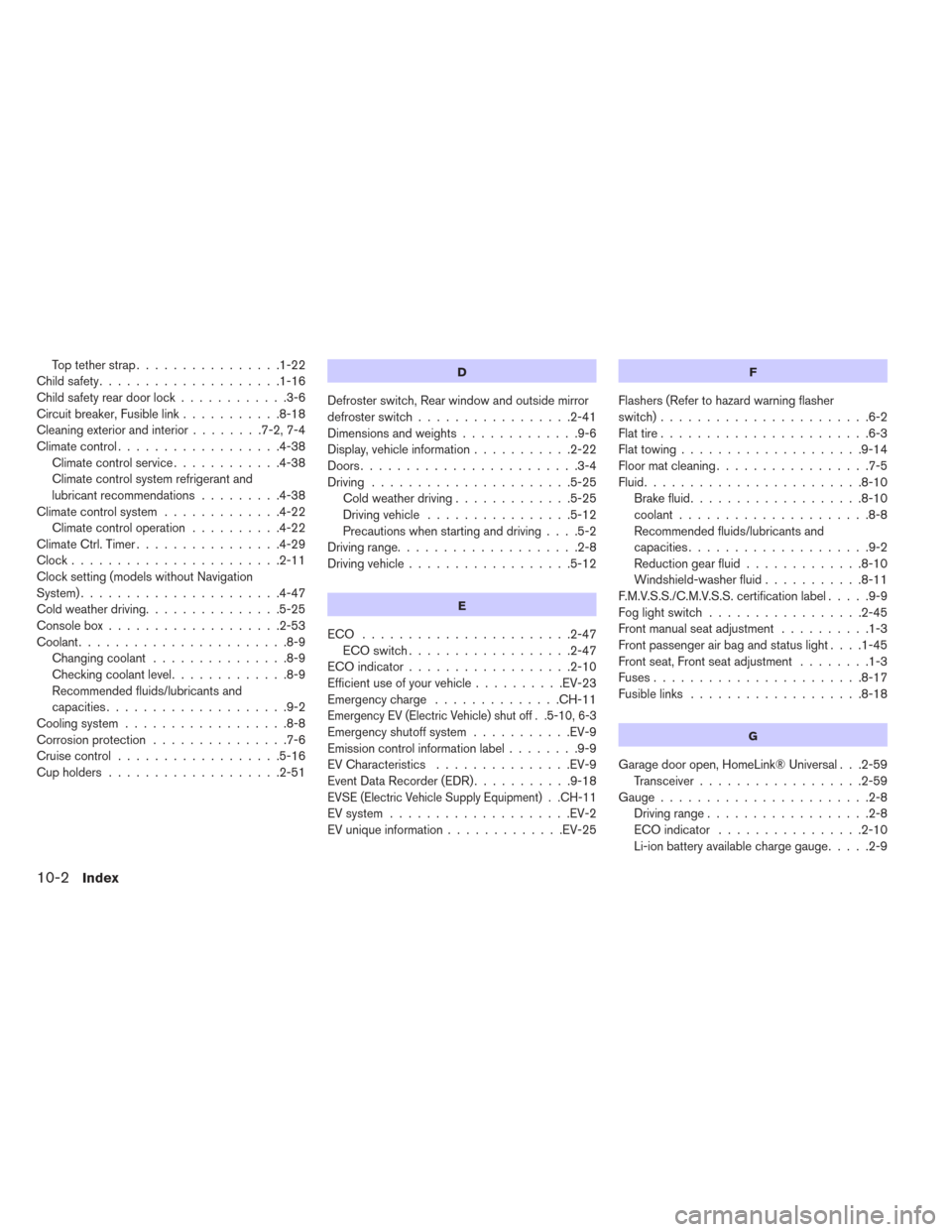
Top tether strap................1-22
Childsafety....................1-16
Child safety rear door lock ............3-6
Circuit breaker, Fusible link ...........8-18
Cleaning exterior and interior ........7-2,7-4
Climatecontrol..................4-38 Climate control service ............4-38
Climate control system refrigerant and
lubricant recommendations .........4-38
Climate control system .............4-22
Climate control operation ..........4-22
Climate Ctrl. Timer ................4-29
Clock.......................2-11
Clock setting (models without Navigation
System) ......................4-47
Cold weather driving ...............5-25
Consolebox...................2-53
Coolant.......................8-9 Changingcoolant ...............8-9
Checkingcoolantlevel.............8-9
Recommended fluids/lubricants and
capacities ....................9-2
Cooling system ..................8-8
Corrosionprotection ...............7-6
Cruisecontrol..................5-16
Cupholders...................2-51D
Defroster switch, Rear window and outside mirror
defroster switch .................2-41
Dimensionsandweights.............9-6
Display, vehicle information ...........2-22
Doors ........................3-4
Driving ......................5-25
Cold weather driving .............5-25
Driving vehicle ................5-12
Precautions when starting and driving ....5-2
Driving range ....................2-8
Driving vehicle ..................5-12
E
ECO .......................2-47
ECO switch ..................2-47
ECOindicator..................2-10
Efficient use of your vehicle ..........EV-23
Emergency charge ..............CH-11
Emergency EV (Electric Vehicle) shut off . .5-10, 6-3
Emergency shutoff system ...........EV-9
Emission control information label ........9-9
EV Characteristics ...............EV-9
Event Data Recorder (EDR) ...........9-18
EVSE (Electric Vehicle Supply Equipment) . .CH-11
EV system....................EV-2
EV unique information .............EV-25
F
Flashers (Refer to hazard warning flasher
switch).......................6-2
Flat tire .......................6-3
Flattowing....................9-14
Floormatcleaning.................7-5
Fluid ........................8-10
Brake fluid ...................8-10
coolant.....................8-8
Recommended fluids/lubricants and
capacities ....................9-2
Reduction gear fluid .............8-10
Windshield-washer fluid ...........8-11
F.M.V.S.S./C.M.V.S.S. certification label .....9-9
Foglightswitch .................2-45
Frontmanualseatadjustment ..........1-3
Front passenger air bag and status light ....1-45
Front seat, Front seat adjustment ........1-3
Fuses.......................8-17
Fusiblelinks ...................8-18
G
Garage door open, HomeLink® Universal . . .2-59 Transceiver ..................2-59
Gauge.......................2-8 Driving range ..................2-8
ECO indicator ................2-10
Li-ion battery available charge gauge .....2-9
10-2Index
Page 416 of 437
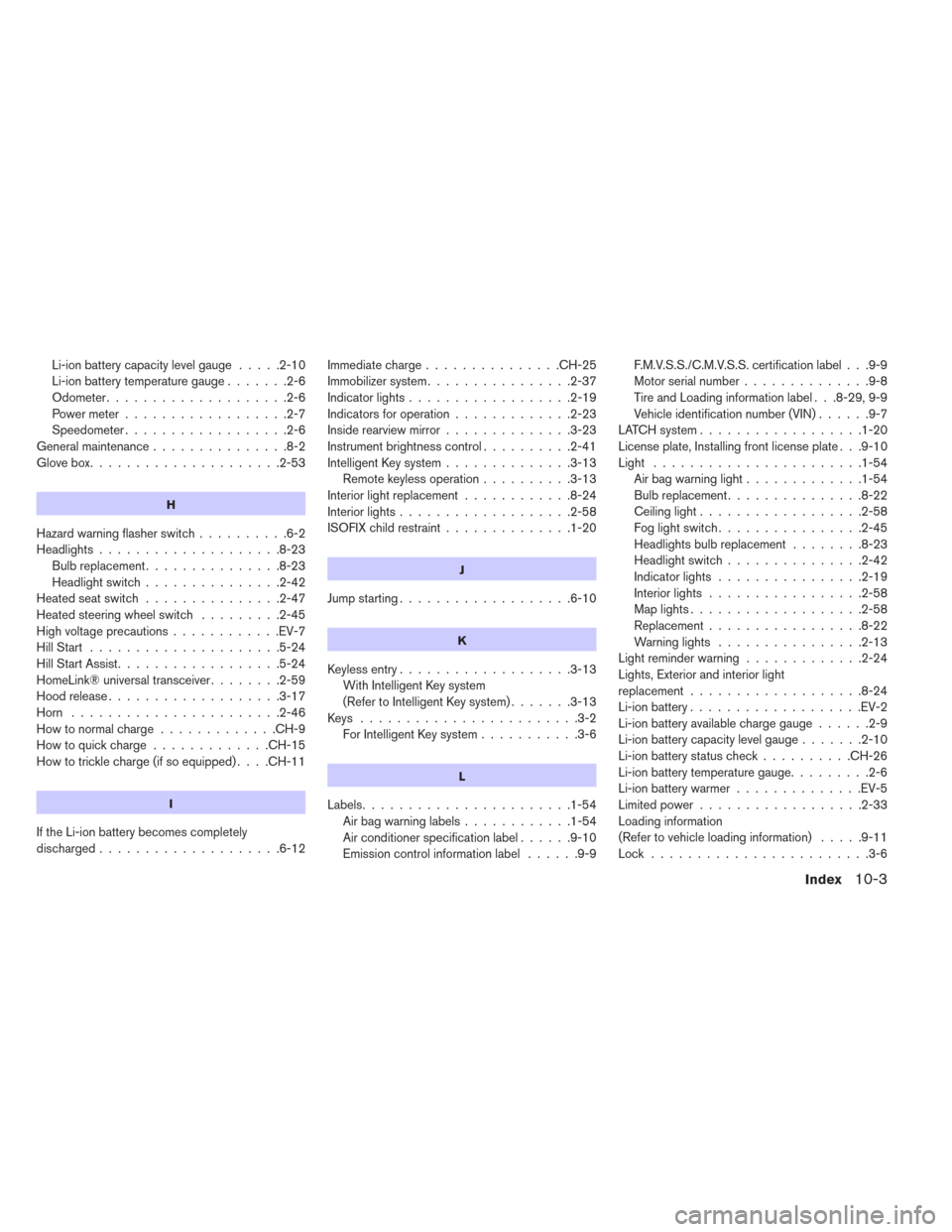
Li-ion battery capacity level gauge.....2-10
Li-ion battery temperature gauge .......2-6
Odometer ....................2-6
Power meter ..................2-7
Speedometer ..................2-6
Generalmaintenance...............8-2
Glovebox.....................2-53
H
Hazard warning flasher switch ..........6-2
Headlights ....................8-23
Bulb replacement ...............8-23
Headlightswitch...............2-42
Heatedseatswitch ...............2-47
Heated steering wheel switch .........2-45
High voltage precautions ............EV-7
HillStart .....................5-24
Hill Start Assist ..................5-24
HomeLink® universal transceiver ........2-59
Hood release ...................3-17
Horn .......................2-46
Howtonormalcharge.............CH-9
Howtoquickcharge.............CH-15
How to trickle charge (if so equipped) ....CH-11
I
If the Li-ion battery becomes completely
discharged....................6-12 Immediate charge
...............CH-25
Immobilizer system ................2-37
Indicatorlights..................2-19
Indicators for operation .............2-23
Inside rearview mirror ..............3-23
Instrument brightness control ..........2-41
Intelligent Key system ..............3-13
Remote keyless operation ..........3-13
Interior light replacement ............8-24
Interior lights ...................2-58
ISOFIX child restraint ..............1-20
J
Jump starting...................6-10
K
Keylessentry...................3-13
With Intelligent Key system
(Refer to Intelligent Key system) .......3-13
Keys ........................3-2 For Intelligent Key system ...........3-6
L
Labels.......................1-54
Airbagwarninglabels............1-54
Air conditioner specification label ......9-10
Emission control information label ......9-9F.M.V.S.S./C.M.V.S.S. certification label . . .9-9
Motor serial number
..............9-8
Tire and Loading information label . . .8-29, 9-9
Vehicle identification number (VIN) ......9-7
LATCH system ..................1-20
License plate, Installing front license plate . . .9-10
Light .......................1-54 Airbagwarninglight.............1-54
Bulb replacement ...............8-22
Ceiling light ..................2-58
Fog light switch ................2-45
Headlightsbulbreplacement ........8-23
Headlightswitch...............2-42
Indicatorlights ................2-19
Interiorlights .................2-58
Maplights...................2-58
Replacement.................8-22
Warning lights ................2-13
Lightreminderwarning .............2-24
Lights, Exterior and interior light
replacement ...................8-24
Li-ion battery ...................EV-2
Li-ion battery available charge gauge ......2-9
Li-ion battery capacity level gauge .......2-10
Li-ion battery status check ..........CH-26
Li-ion battery temperature gauge .........2-6
Li-ion battery warmer ..............EV-5
Limited power ..................2-33
Loading information
(Refer to vehicle loading information) .....9-11
Lock ........................3-6
Index10-3
Page 417 of 437
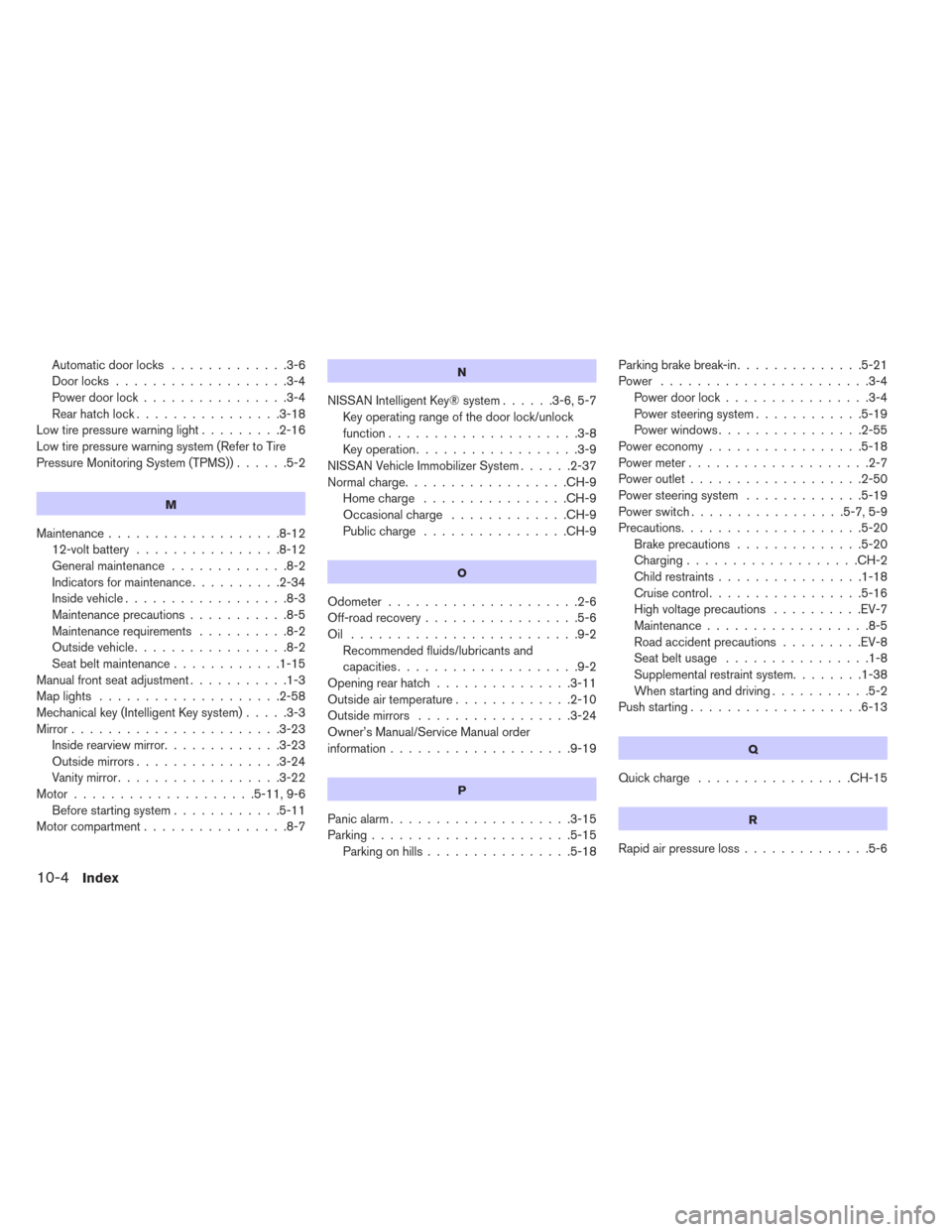
Automatic door locks.............3-6
Door locks ...................3-4
Power door lock ................3-4
Rearhatchlock................3-18
Low tire pressure warning light .........2-16
Low tire pressure warning system (Refer to Tire
Pressure Monitoring System (TPMS)) ......5-2
M
Maintenance...................8-12
12-volt battery ................8-12
Generalmaintenance .............8-2
Indicatorsformaintenance..........2-34
Inside vehicle ..................8-3
Maintenance precautions ...........8-5
Maintenance requirements ..........8-2
Outside vehicle .................8-2
Seatbeltmaintenance............1-15
Manual front seat adjustment ...........1-3
Maplights ....................2-58
Mechanical key (Intelligent Key system) .....3-3
Mirror .......................3-23
Inside rearview mirror.............3-23
Outside mirrors ................3-24
Vanity mirror ..................3-22
Motor....................5-11,9-6 Before starting system ............5-11
Motor compartment ................8-7
N
NISSAN Intelligent Key® system ......3-6,5-7
Key operating range of the door lock/unlock
function.....................3-8
Key operation ..................3-9
NISSAN Vehicle Immobilizer System ......2-37
Normalcharge..................CH-9 Home charge ................CH-9
Occasional charge .............CH-9
Publiccharge ................CH-9
O
Odometer .....................2-6
Off-road recovery .................5-6
Oil .........................9-2 Recommended fluids/lubricants and
capacities ....................9-2
Opening rear hatch ...............3-11
Outside air temperature .............2-10
Outside mirrors .................3-24
Owner’s Manual/Service Manual order
information ....................9-19
P
Panic alarm....................3-15
Parking ......................5-15
Parking on hills ................5-18 Parking brake break-in
..............5-21
Power .......................3-4 Power door lock ................3-4
Power steering system ............5-19
Power windows ................2-55
Powereconomy.................5-18
Powermeter....................2-7
Power outlet ...................2-50
Power steering system .............5-19
Powerswitch.................5-7,5-9
Precautions ....................5-20
Brake precautions ..............5-20
Charging ...................CH-2
Child restraints ................1-18
Cruise control .................5-16
High voltage precautions ..........EV-7
Maintenance..................8-5
Road accident precautions .........EV-8
Seatbeltusage ................1-8
Supplemental restraint system ........1-38
When starting and driving ...........5-2
Push starting ...................6-13
Q
Quickcharge .................CH-15
R
Rapid air pressure loss ..............5-6
10-4Index
Page 418 of 437
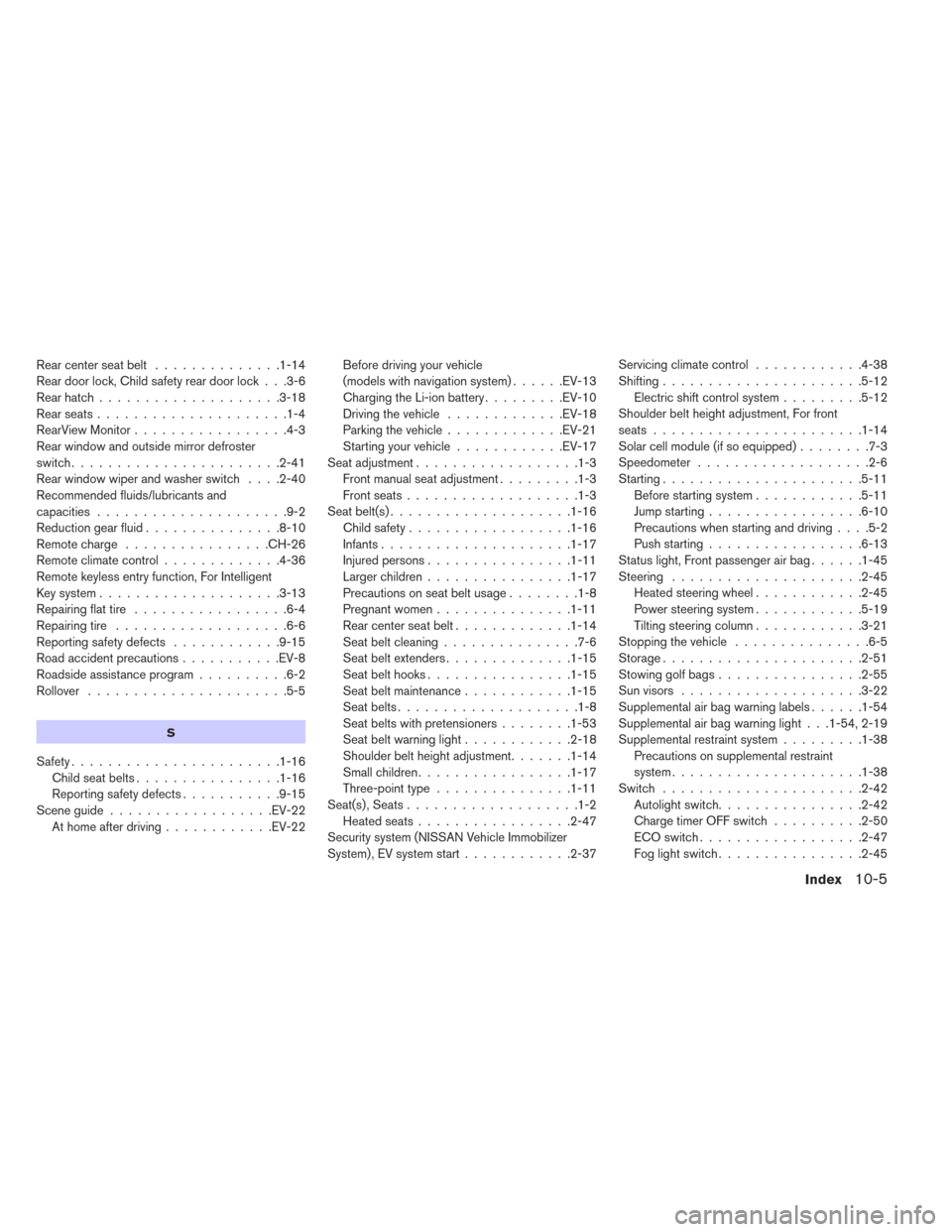
Rearcenterseatbelt ..............1-14
Rear door lock, Child safety rear door lock . . .3-6
Rear hatch....................3-18
Rearseats.....................1-4
RearView Monitor .................4-3
Rear window and outside mirror defroster
switch .......................2-41
Rear window wiper and washer switch ....2-40
Recommended fluids/lubricants and
capacities .....................9-2
Reductiongearfluid...............8-10
Remotecharge ................CH-26
Remoteclimatecontrol.............4-36
Remote keyless entry function, For Intelligent
Keysystem....................3-13
Repairing flat tire .................6-4
Repairing tire ...................6-6
Reporting safety defects ............9-15
Road accident precautions ...........EV-8
Roadside assistance program ..........6-2
Rollover ......................5-5
S
Safety .......................1-16
Childseatbelts................1-16
Reporting safety defects ...........9-15
Sceneguide..................EV-22 At home after driving ............EV-22 Before driving your vehicle
(models with navigation system)
......EV-13
Charging the Li-ion battery .........EV-10
Driving the vehicle .............EV-18
Parking the vehicle .............EV-21
Starting your vehicle ............EV-17
Seat adjustment ..................1-3
Front manual seat adjustment .........1-3
Frontseats...................1-3
Seat belt(s) ....................1-16
Child safety ..................1-16
Infants.....................1-17
Injuredpersons................1-11
Largerchildren................1-17
Precautions on seat belt usage ........1-8
Pregnant women ...............1-11
Rear center seat belt .............1-14
Seatbeltcleaning...............7-6
Seatbeltextenders..............1-15
Seat belt hooks ................1-15
Seat belt maintenance ............1-15
Seatbelts....................1-8
Seat belts with pretensioners ........1-53
Seatbeltwarninglight............2-18
Shoulder belt height adjustment .......1-14
Smallchildren.................1-17
Three-point type ...............1-11
Seat(s) , Seats ...................1-2
Heatedseats.................2-47
Security system (NISSAN Vehicle Immobilizer
System) , EV system start ............2-37 Servicing climate control
............4-38
Shifting ......................5-12
Electric shift control system .........5-12
Shoulder belt height adjustment, For front
seats .......................1-14
Solar cell module (if so equipped) ........7-3
Speedometer ...................2-6
Starting ......................5-11
Before starting system ............5-11
Jump starting .................6-10
Precautions when starting and driving ....5-2
Push starting .................6-13
Status light, Front passenger air bag ......1-45
Steering .....................2-45 Heated steering wheel ............2-45
Power steering system ............5-19
Tilting steering column ............3-21
Stopping the vehicle ...............6-5
Storage......................2-51
Stowing golf bags ................2-55
Sun visors ....................3-22
Supplemental air bag warning labels ......1-54
Supplemental air bag warning light . . .1-54, 2-19
Supplemental restraint system .........1-38
Precautions on supplemental restraint
system .....................1-38
Switch ......................2-42 Autolight switch ................2-42
Charge timer OFF switch ..........2-50
ECO switch ..................2-47
Fog light switch ................2-45
Index10-5